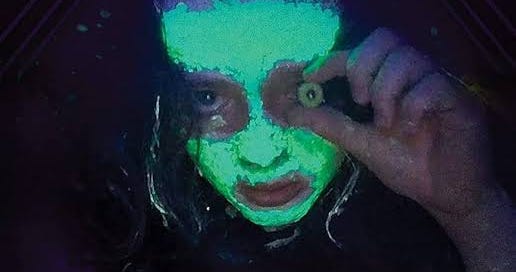In the first few minutes of We're All Going To The World's Fair, the only thing I could think of was how much the lighting reminded me of the critically acclaimed I Saw The TV Glow from last year. It is five minutes or so into the film, when the title cards start showing, that I see it was also written and directed by the same person.
Here, in her debut feature film, Jane Schoenburn lays the foundation for all the themes and stylistic choices that will reoccur in her followup: a main character who lives in a small town that feels isolated from them and you almost wonder if they're its only inhabitant; turning to some form of media as a means of escapism; troubled parental relationships; and a flurry of activities that straddle the line between normal and paranormal.
In the opening scene, Casey, our main character, decides to participate in an online role-playing horror game called the World's Fair, made up of a small online community— scattered everywhere— who share self-recorded footages of themselves as certain changes begin to happen to them after joining the game. After the ritual like application process—which consists of a repetition of the words, “I want to go to the World's Fair” three times, pricking your thumb with a pin, and thumbing it on your laptop's screen— nothing happens to Casey, leaving her frustrated, constantly viewing the experiences of other players on her computer. But as the film progresses and she records the strange things happening to her, we begin to lose sight of what is real and what is not.
Schoenburn makes such interesting directorial choices with how she chooses to tell her story. There's the budding confusion as Casey continues to participate in the game, and we are watching her commit more and more to it, but at the same time forgetting that it's a game. She is also being watched by members of the community, but particularly by the only other character shown in the film: a middle-aged man monitoring her and other players of the game. It becomes increasingly hard to tell whether the reports Casey gives of the things happening to her are true or not, whether it's real or a performance.
For such a small film, Schoenburn manages to do enough where although the effects used seem basic and the choices tame, the feeling of dread and discomfort are constantly building and at some point become palpable. It's in the multi-colored flickering lights, the small spaces, the vastness and emptiness of the town, the silences that feel so human and necessary. Anna Cobb is fantastic in her role and her commitment to the double acting—both in the large scale of the film, but also in the game— sells it even more.
In its entirety, We Are All Going To The World's Fair is an exploration of the singular, all-consuming loneliness you feel as a teenager when there's nowhere to put it. In this case, it is loneliness in a small town and a young girl's desire for escapism from the world through an online game that begins to feel too literal. How does one take oneself out their life? In hindsight, certain things in I Saw The TV Glow makes more sense to me now, seeing it acts as an expanded version of this film, just with different circumstances. Schoenburn does a fantastic job of sucking you into the small world she creates. I found the ending very moving. Sometimes all we desire is to be seen.
Rating:
★★★★✰




